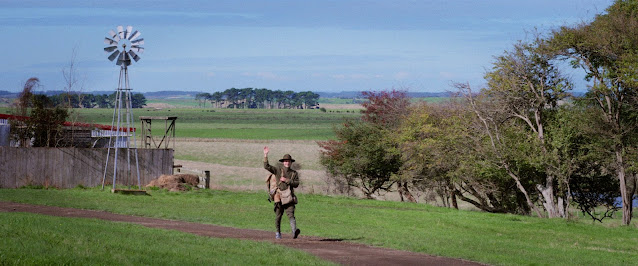Anchoress (1993)
Anchoress is unique amongst the films I've covered that could be considered folk horror: for one, it's concerned primarily with Christian sacrifice as opposed to pagan, and the fair maiden who sacrifices herself does so voluntarily. You see, our heroine Christine sees a statue of the Virgin Mary one day out in the fields and immediately makes up her mind to dedicate her life to this holy icon. The local priest tells her the story of a previous anchoress, who walled herself up in the church as an offering to Mary, which Christine decides is exactly what she wants to do. The big question the film leaves us with is whether or not the force that is inspiring Christine is really the Virgin at all, and not some other, more subterranean sort of supernatural force that seeks to draw her deeper and deeper into the Earth for reasons unknown.
Local villagers are initially quite uneasy with the slow sacrifice, but perhaps none more so than Christine's mother, a woman oft-accused of witchcraft. But once Christine has been walled up in the church, the villagers find themselves asking Christine for advice in all sorts of matters, things they probably should be praying about according to their religion. Christine becomes less of a saint and more of an object of outright worship as things develop, but it's clear to us, the audience, that she one hundred percent answers to some kind of higher power, but which, it's hard to say. Touching of the face and hands is often involved in visits between Christine and the townfolk, presumably as a blessing of sorts, but the local priest is not happy about this when he finds out. You see, he believes touch is the devil's way into any man's, and especially any woman's, heart. Christine's reply is simply "But she touches us!" This disagreement between Christine's earnest divine inspiration and the priest's cynical, old testament outlook eventually threatens to spiral out of control, and it isn't long before things turn violent.
Christine is a fascinating character for reasons previously mentioned, but also because there's always the possibility that she's having some kind of psychotic break from reality that's simply interpreted as supernatural: she often hears voices and has 'fits,' in addition to the whole "I want to be walled up with the Virgin icon" thing. Things eventually turn erotic when Christine becomes obsessed with the texture of the earth around her and the way it feels, which transitions into an equal appreciation of her own body's natural texture and feel, which the priest finds extremely disturbing. Things are kept ambiguous enough to frustrate the less patient viewers in the audience, but as someone who's been riding along a quite singular wavelength of rural, earthen imagery and pagan symbolism lately, I thought its blend of ideas was quite engaging and interesting to ponder.
Anchoress is definitely a star-studded affair in its own way. We have Christopher Eccleston of Doctor Who fame as the infinitely hatable priest, and none other than Pete Postlethwaite, aka Kobayashi from The Usual Suspects, as Christine's father. The cast overall does a magnificent job bringing this story to life, especially our lead. The film's strongest asset, though, may be its visuals, which are a sumptuous treat throughout. Creative, thoughtful, and bold cinematography dances about as striking black-and-white imagery spins endless art out of a dirty village and its surrounding countryside. The imagery of wheat mixed with braids of human hair was inspired. The score is sparse and used sparingly and subtly, with silence being what we hear most during dialogue and tense scenes, but when it comes to life, it's powerful stuff. The choral music that played during the end credits, in particular, gave me chills, and underscores perfectly the strange, enigmatic ending. Anchoress shouldn't be missed by any fan of this particular blend of horror, though for most this one would fall more into folk drama more than anything.
The biggest disappointment with this disc is two-fold: BFI provided the transfer, which is woefully inadaquate and quite blocky, especially when scenes get busy. A shame considering how gorgeous and meticulously crafted its visuals are. But the worst part is Severin's subtitle job, which is just plain atrocious. It's been spotty here and there throughout All the Haunts Be Ours so far, but this particular disc has nearly every other word being a misinterpretation or mishearing, and that's whenever the subtitles don't simply read "[unintelligible]" for whole scenes. So if you're hard of hearing, fair warning, as I think the one who wrote up the subtitles for this blu-ray release may have been as well.




Comments
Post a Comment